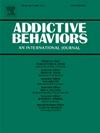Prospective associations between smoking abstinence and anhedonia among people who seek smoking cessation treatment
IF 3.6
2区 医学
Q1 PSYCHOLOGY, CLINICAL
引用次数: 0
Abstract
Introduction
Depression has been broadly studied in association with tobacco smoking. However, little is known about the prospective association between anhedonia, one of the core symptoms of depression, and smoking outcomes after smoking cessation treatment. The goal of this study was to examine the bidirectional and longitudinal relation between anhedonia and smoking abstinence after smoking cessation intervention and up to a 12-month follow-up.
Methods
The sample was composed of 685 participants (Mage = 45.51; 62 % female) that were enrolled in three cognitive-behavioural smoking cessation interventions. Anhedonia and smoking abstinence were measured at post-treatment, and at 3-, 6- and 12-month follow-ups. The bidirectional and longitudinal association was analysed applying a Random Intercept Cross-Lagged Panel Model (RI-CLPM), and results were controlled for the effects of sex and differing studies.
Results
The RI-CLPM showed that smoking abstinence in one timepoint predicted lower anhedonia at the following timepoint for each assessment. Although greater anhedonia was related to lower smoking abstinence crossectionally at post-treatment, 6- and 12-month follow-ups, precedent anhedonia did not predict consequent smoking abstinence at any follow-up. The results were consistent when controlling potential confounding variables.
Conclusions
The bidirectional analysis indicated that smoking abstinence predicted lower anhedonia after a smoking cessation intervention during the course of 12 months, but anhedonia did not significantly predict smoking abstinence at any consequent timepoint. Findings have relevant implications as may serve to motivate healthcare professionals to apply tailored smoking cessation interventions, and people who smoke to quit due to the potential impact on mood.
在寻求戒烟治疗的人群中,戒烟和快感缺乏之间的前瞻性联系
抑郁症与吸烟之间的关系已被广泛研究。然而,对于快感缺乏(抑郁症的核心症状之一)与戒烟治疗后的吸烟结果之间的预期关联知之甚少。本研究的目的是研究戒烟干预后快感缺乏与戒烟之间的双向和纵向关系,并进行长达12个月的随访。方法共685名受试者(年龄= 45.51;(62%为女性),参与了三种认知行为戒烟干预。在治疗后、3个月、6个月和12个月的随访中测量快感缺乏和戒烟情况。应用随机截距交叉滞后面板模型(RI-CLPM)分析了双向和纵向关联,并控制了性别和不同研究的影响。结果RI-CLPM显示,一个时间点的戒烟预测下一个时间点的快感缺缺性较低。尽管在治疗后、6个月和12个月的随访中,更严重的快感缺乏与更低的戒烟率相关,但在任何随访中,先前的快感缺乏并不能预测随后的戒烟率。在控制潜在的混杂变量时,结果是一致的。结论双向分析表明,戒烟干预后12个月内,戒烟可以预测较低的快感缺乏症,但快感缺乏症在随后的任何时间点都不能显著预测戒烟。研究结果具有相关的意义,可能有助于激励医疗保健专业人员应用量身定制的戒烟干预措施,以及吸烟者戒烟,因为吸烟对情绪的潜在影响。
本文章由计算机程序翻译,如有差异,请以英文原文为准。
求助全文
约1分钟内获得全文
求助全文
来源期刊

Addictive behaviors
医学-药物滥用
CiteScore
8.40
自引率
4.50%
发文量
283
审稿时长
46 days
期刊介绍:
Addictive Behaviors is an international peer-reviewed journal publishing high quality human research on addictive behaviors and disorders since 1975. The journal accepts submissions of full-length papers and short communications on substance-related addictions such as the abuse of alcohol, drugs and nicotine, and behavioral addictions involving gambling and technology. We primarily publish behavioral and psychosocial research but our articles span the fields of psychology, sociology, psychiatry, epidemiology, social policy, medicine, pharmacology and neuroscience. While theoretical orientations are diverse, the emphasis of the journal is primarily empirical. That is, sound experimental design combined with valid, reliable assessment and evaluation procedures are a requisite for acceptance. However, innovative and empirically oriented case studies that might encourage new lines of inquiry are accepted as well. Studies that clearly contribute to current knowledge of etiology, prevention, social policy or treatment are given priority. Scholarly commentaries on topical issues, systematic reviews, and mini reviews are encouraged. We especially welcome multimedia papers that incorporate video or audio components to better display methodology or findings.
Studies can also be submitted to Addictive Behaviors? companion title, the open access journal Addictive Behaviors Reports, which has a particular interest in ''non-traditional'', innovative and empirically-oriented research such as negative/null data papers, replication studies, case reports on novel treatments, and cross-cultural research.
 求助内容:
求助内容: 应助结果提醒方式:
应助结果提醒方式:


